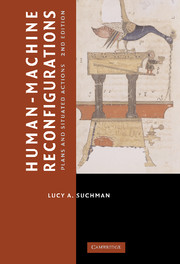Book contents
- Frontmatter
- Contents
- Acknowledgments
- Preface to the 2nd Edition
- Introduction
- 1 Readings and Responses
- 2 Preface to the 1st Edition
- 3 Introduction to the 1st Edition
- 4 Interactive Artifacts
- 5 Plans
- 6 Situated Actions
- 7 Communicative Resources
- 8 Case and Methods
- 9 Human–Machine Communication
- 10 Conclusion to the 1st Edition
- 11 Plans, Scripts, and Other Ordering Devices
- 12 Agencies at the Interface
- 13 Figuring the Human in AI and Robotics
- 14 Demystifications and Reenchantments of the Humanlike Machine
- 15 Reconfigurations
- References
- Index
3 - Introduction to the 1st Edition
Published online by Cambridge University Press: 05 June 2012
- Frontmatter
- Contents
- Acknowledgments
- Preface to the 2nd Edition
- Introduction
- 1 Readings and Responses
- 2 Preface to the 1st Edition
- 3 Introduction to the 1st Edition
- 4 Interactive Artifacts
- 5 Plans
- 6 Situated Actions
- 7 Communicative Resources
- 8 Case and Methods
- 9 Human–Machine Communication
- 10 Conclusion to the 1st Edition
- 11 Plans, Scripts, and Other Ordering Devices
- 12 Agencies at the Interface
- 13 Figuring the Human in AI and Robotics
- 14 Demystifications and Reenchantments of the Humanlike Machine
- 15 Reconfigurations
- References
- Index
Summary
The famous anthropological absorption with the (to us) exotic … is, thus, essentially a device for displacing the dulling sense of familiarity with which the mysteriousness of our own ability to relate perceptively to one another is concealed from us.
(Geertz 1973: 14)The problem of shared understanding, or mutual intelligibility. has defined the field of social studies for the past hundred years. On the one hand, interpreting the actions of others has been the social scientist's task; to come up with accounts of the significance of human actions is, after all, the principal charge of ethnographic anthropology. On the other hand, to understand the mutual intelligibility of action as a mundane, practical accomplishment of members of the society is, in large measure, the social scientist's problem or subject matter. An account of that accomplishment would constitute an account of the foundation of social order. Although studies of mutual intelligibility have been concerned exclusively with human action, we now have a technology that has brought with it the idea that rather than just using machines, we interact with them as well. Already, the notion of “human–machine interaction” pervades both technical and popular discussion of computers, whether about their design or their use. In the debate over specific problems in the design and use of interactive machines, however, no question is raised about the bases for the very idea of human–machine interaction as such.
- Type
- Chapter
- Information
- Human-Machine ReconfigurationsPlans and Situated Actions, pp. 29 - 32Publisher: Cambridge University PressPrint publication year: 2006
- 1
- Cited by

